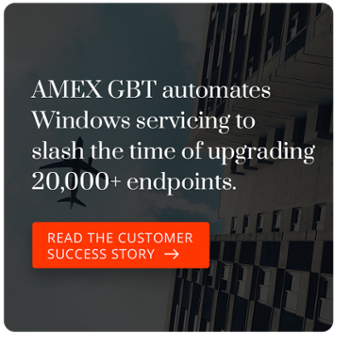Anywhere operations is a term Gartner coined for a business model that assumes enterprise end users – employees or customers – could be working, interacting with, or accessing services from anywhere. Adoption has been accelerated by the pandemic, requiring IT teams to adapt to new ways of working.
We discussed the challenges of delivering anywhere operations in a previous article and will continue to expand on the five areas that Gartner suggests IT focus on. Here we will look at the challenges and opportunities of automating endpoint operations and in future articles we’ll investigate:
- Adapting Infrastructure to new ways of working
- Enhancing end user productivity and collaboration
- Optimizing cloud and edge infrastructure
- Improving the digital experience
As enterprise employees became more mobile, managing endpoint operations became more complex. With initiatives such as bring-your-own-device (BYOD) and growing cloud adoption it’s become a real struggle to get a current view of where all your enterprise endpoints are, who is using them, how they are being used, and what they are accessing.
2020 added a whole new set of problems. You still had to maintain performance and security for end users, but few, if any, were working in offices. That meant helpdesk teams needed to help non-technical end users set up their home offices, roll out OS updates and new collaboration tools over patchy home broadband networks, and spend even more time trying to find out where to ship equipment.
It became difficult to stay on top of demand for collaboration tools and shadow IT began to rise. Already an issue, the purchasing of unsanctioned software and applications has been made easier by cloud adoption and is growing further as more employees use their personal devices for work.
With IT assets more dispersed, managing endpoints for anywhere operations becomes even more complex. It will require an agile approach to adapt quickly to rapidly changing market and end user demands. And that means reducing the risk of impacting operations and end users as you roll out change.
The barriers to agile endpoint management
IT agility is a huge challenge. To manage the endpoint lifecycle – from acquisition to disposal – many teams rely on outdated, inefficient, manual processes. Performed this way, each stage of endpoint operations – aggregating and analyzing asset and user information, planning, communicating with and scheduling end users, or rolling out changes and reporting – takes up huge amounts of time, headcount, and budget.
If the future is digital, why is manual the default delivery method? It’s largely due to the tools that IT teams have invested in or leverage to oversee and manage the environment – including CMDB’s, ITSM’s, Access Management Systems, HR databases, and other data repositories. Unfortunately, these technologies create data silos, don’t manage across the infrastructure, and introduce risk into IT programs.
To maintain anywhere operations, you must be able to quickly analyze your environment and understand how changes will impact the business, users, and customers. But without a clear view of that environment your role becomes practically impossible.
If you’re going to use manual processes and spreadsheets to manage anywhere operations, you’re always going to be playing catch up. Because you’re working from out of date or incorrect data, it’s going to be hard to assess the impact of changes or identify potential areas of risk. As programs progress, the issues created by bad data are amplified by all the other manual tasks you undertake. You have to correct more problems, project timelines lengthen, and budgets and IT teams are stretched even further.

Change is required to deliver anywhere operations
It’s time to ditch the spreadsheets and outdated manual processes and automate endpoint operations. To deliver anywhere operations successfully you need to find a way to:
- Access a real-time, 360° view of your environment to see how changes will impact the business and end users and understand the risks you need to manage.
- Clearly identify where assets are in their lifecycle so that you can optimize performance and costs and maintain security at every stage.
- Swiftly understand end user requirements to speed the delivery of new assets and applications.
- Maintain compliance, security, and performance by getting a clear view what is being used and accessed.
- Dynamically optimize and balance cloud resources to maintain support as demands change.
Anywhere operations will continue to evolve over time. To manage endpoint operations more efficiently and reduce business risk, consider adopting a digital platform conductor (DPC).
A digital platform conductor quickly connects to and orchestrates all your disparate IT infrastructure management tools. Leveraging artificial intelligence (AI) and machine learning (ML), a DPC automates the process of aggregating and normalizing data from those tools to deliver a real-time view of the IT environment and the complex dependencies within it. With this information you’ll be able to better understand how changes could impact the environment, the areas of risks you need to address, and how and when to rollout change.
By orchestrating your tools, a DPC will allow you to automate workflows and tasks across any IT program including planning, communications, scheduling, rollout, and reporting. Using automation your teams will benefit from predictable results and remain within budgets and timelines ensuring that changes support business growth, and don’t impede operations.
Book a demo to understand how ReadyWorks, a DPC, can transform your endpoint operations and enable teams to become more agile as they support anywhere operations.
